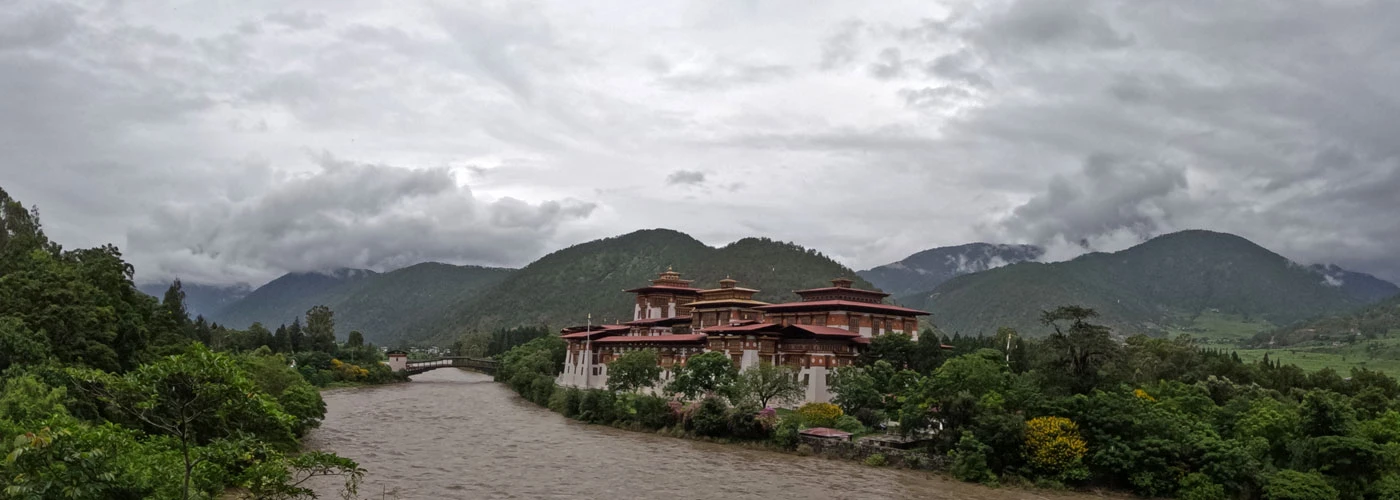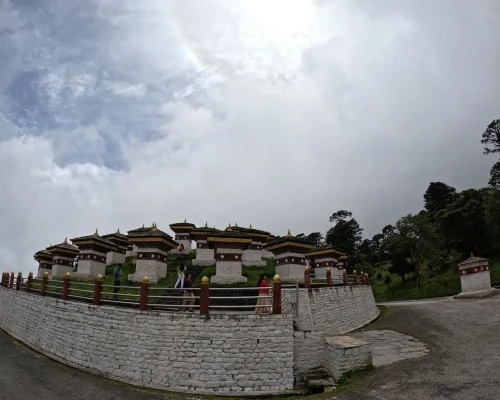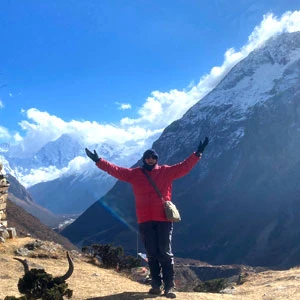Best Time For Bhutan Tour
Bhutan is a year-round destination, but the best time to visit for a comfortable and visually rewarding experience is during Spring (March to May) and Autumn (September to November). These seasons offer the most pleasant weather, clear mountain views, vibrant cultural festivals, and excellent road conditions.
Spring (March to May)
Spring in Bhutan is known for its mild weather, blossoming forests, and vibrant landscapes. Here, daytime temperatures generally range from 15°C to 25°C, depending on the altitude. Likewise, the skies are typically clear with excellent visibility.
As you drive through valleys and forests, you will find rhododendrons in full bloom along with magnolias, wild orchids, and primulas. If you are lucky, you might spot wildlife such as musk deer, red pandas, or exotic birds like Himalayan monals and blood pheasants.
Moving on, Spring is also a season of celebration. One of the most iconic festivals during this time is the Paro Tsechu, which is held in the Paro Dzong courtyard. During this celebration, you will get to witness sacred masked dances and colorful rituals.
Autumn (September to November)
Autumn is another peak season with crisp, clear skies, stable weather, and cooler temperatures, generally between 12°C and 20°C during the day. This is the best time for unobstructed Himalayan views, especially of dramatic peaks such as Gangkar Puensum, Jomolhari, Masang Gang, and Tsendagang.
Since the Monsoon rains have passed, the air is much cleaner and the landscapes are lush and green. Similarly, the roads are also dry and safe. During this season, you will also witness the Thimphu Tsechu and Wangduephodrang Tsechu. For this celebration, the locals will gather in traditional attire, and some masked monks will perform ancient Cham dances.
Off-Seasons (Monsoon & Winter)
Summer (June to August) and Winter (December to February) are the off-season months. Summer brings the Monsoon, especially in southern and central Bhutan. You will experience heavy rainfalls that can lead to landslides, road closures, and poor visibility.
Moving on, Winter, while dry and clear in some valleys like Paro and Thimphu, can bring extremely cold temperatures, especially in high-altitude areas. Snowfall may block mountain passes such as Dochula, cutting off road access.
Bhutan Tour Difficulty
The Bhutan tour is generally considered easy, hence, even travellers with basic fitness of any age group can take on this journey. Unlike high-altitude expeditions or strenuous mountain treks, this classic cultural itinerary involves comfortable drives, short walks, and light hikes.
Having said that, there may be several factors that can influence the overall difficulty of the experience, depending on your personal readiness.
Altitude
One of the most defining elements during the tour is altitude. While you won’t be trekking through extreme elevations, places like Dochula Pass (3,080 meters) and even Tiger’s Nest Monastery (around 3,120 meters) sit high enough to cause mild altitude symptoms. You may experience signs such as fatigue or shortness of breath, especially if you are not acclimatized.
Especially, the Taktsang Monastery hike involves a steep uphill climb that takes around 2 to 3 hours one way. While the trail here is well-maintained, the combination of altitude, incline, and duration can feel strenuous.
Road Travel & Motion Sickness
Another factor is road travel. Since Bhutan has mountainous terrain, you will be driving across frequent curves and changes in elevation. For some, especially if you are prone to motion sickness, these drives can be physically tiring.
Weather Unpredictability
While Spring and Autumn seasons offer stable climates, you may face sudden rains or snow, especially if you are travelling during shoulder season.
In Spring, although the days are mostly sunny and pleasant, early March can still carry the chill of winter. Similarly, by the end of May, the pre-monsoon showers may start to appear, especially in the southern and central valleys.
Likewise, in late autumn, especially after mid-November, the air turns colder, and you may encounter early winter snowfalls at higher elevations.
Walking Duration & Fatigue
While you will be driving for the majority of the tour, you will need to walk on several instances while visiting the monasteries. Now, these monastery paths are quite uneven. Here, you will climb stairs in ancient fortresses, or navigate narrow village trails.
For example, when visiting places like Trashichhoedzong in Thimphu or Rinpung Dzong in Paro, you will walk through large courtyards, climb steep stairways carved into stone, and move between various temple halls. Similarly, in rural areas, like around Wangduephodrang or during the hike to Tiger’s Nest Monastery, the paths may take you through forested trails, suspension bridges, or village lanes.
Altogether, the famous Taktsang hike in particular is a notable challenge due to its length (around 5 hours round-trip), elevation gain, and narrow ledges. Even though mules are available part way up, you will still need to complete sections on foot.
Accommodation
Depending on your travel style, budget, and personal interests, you can choose from a wide range of accommodation options in Bhutan.
If you are seeking comfort, you should book luxury lodges. These lodges are often managed by renowned international brands or curated local boutique operators. Here, you will find elegantly furnished rooms that blend traditional Bhutanese craftsmanship with modern luxury. Similarly, you will also get personalized service, spa treatments, wellness centers, and gourmet dining.
However, if you prefer a comfortable but a more modest experience, you should try boutique hotels or resorts. These mid-range options embrace local design aesthetics with cozy interiors.
Now, you can also choose to stay close to nature with adventure lodges. They provide clean, functional spaces located near national parks, trekking trails, or riversides. Though simpler in design, these lodges offer easy access to the outdoors.
Finally, if you are drawn to an authentic experience, you must stay in a traditional guesthouse or farmhouse. They are budget-friendly stays, mostly found in rural areas. You will sleep on traditional beds, enjoy home-cooked Bhutanese meals, and may even join your host family in daily chores or farming activities.
Meals
Throughout your journey, you will discover that Bhutanese cuisine is quite bold in flavor. Their dishes are warming, hearty, and often spiced with an unmistakable love for chilies.
You will typically enjoy three full meals a day, beginning with breakfast at your hotel or lodge. Morning meals usually feature a fusion of Western-style options like toast, scrambled or boiled eggs, porridge, cereal, pancakes, and fresh fruits. You can also enjoy Bhutanese staples such as rice porridge or butter tea (Suja). Butter tea is a unique drink made from churned tea leaves, butter, and salt which is particularly soothing in higher altitudes.
Lunch and dinner are often served buffet-style, especially in tourist hotels and restaurants, that caters to both local taste and international palates. The meals revolve around locally grown red or white rice. It then includes seasonal vegetables such as fiddlehead ferns (known locally as Nakey), pumpkin, spinach, and radish, along with stir-fried meat dishes featuring chicken, pork, or beef.
Furthermore, you will find lentil or chickpea soups. Lastly, the meals are almost always accompanied by Ezay. It is a fiery Bhutanese chili paste made with garlic, tomatoes, and chili flakes.
Now, while in Bhutan, you must taste their national dish, Ema Datshi. It is a fiery, comforting stew of green or red chilies simmered with homemade cheese (datshi). You can also find multiple variations like Kewa Datshi (with potatoes), Shamu Datshi (with mushrooms), and even Shakam Datshi (with dried beef).
Another must-try is Phaksha Paa. It is a rich pork dish stir-fried with dried chilies and daikon radish. Generally, it is cooked during special occasions and festivals. Moving on, you might also try Jasha Maru (spicy chicken stew with ginger, garlic, and fresh coriander) and Shakam Paa (made from air-dried beef stir-fried with radish and dried chilies).
Now, if you want a varied taste, you will also easily find Indian curries, Chinese-style stir-fries, continental fare, and even Italian-inspired dishes like pasta and pizza. In larger towns, you may come across bakeries and cafés serving espresso, pastries, and sandwiches.
In terms of drinks, the most famous traditional beverage is Suja, which can be quite salty. For a truly local experience, you can also try Ara, a traditional distilled spirit made from fermented rice, wheat, maize, or barley. At times, it is also infused with butter, eggs, or medicinal herbs.
Electricity & Charging Facilities
As you travel through cities like Paro, Thimphu, and Punakha, you will find that nearly all hotels, resorts, and even guest houses are equipped with 24/7 electricity. Most accommodations here provide standard electrical outlets compatible with Type D, F, and G plugs.
During your stay, you will have access to charging points in your room, hotel lobbies, lounges, and dining areas. However, basic guest houses or farm stays may have limited sockets, so you must carry a multi-port charger and a power bank.
In rural or higher-altitude areas, locals generally use backup generators or solar-powered alternatives. While many restaurants and lunch stops also allow device charging, some may only offer the service to paying customers.
Internet Connectivity
Despite its rugged mountains and remote valleys, Bhutan offers surprisingly reliable internet connectivity, especially in areas popular with travelers. In urban cities, most hotels, guest houses, and resorts provide complimentary Wi-Fi. Luxury lodges tend to offer high-speed access, while budget accommodations may have slower speeds or limited coverage.
Similarly, you may also find Wi-Fi-enabled cafés, restaurants, and even souvenir shops. Some of them may offer free access, while some might charge a small fee or provide passwords to paying customers only.
Now, if you are planning to stay connected throughout the journey, it is best to purchase a local SIM card. There are two main telecom providers in Bhutan, Bhutan Telecom (B-Mobile) and TashiCell. Both of these offer affordable prepaid SIM cards and data packages that work well in most tourist destinations.
You can easily buy a SIM at the airport in Paro or at retail outlets in town with just your passport. These local SIMs allow you to use 4G mobile internet in most parts of the country, although signal strength may weaken in remote valleys.
Travel Insurance
The Royal Government of Bhutan requires all international travelers to carry valid travel insurance that covers them for the full duration of their stay. Without it, you may be denied entry at immigration.
Your travel insurance policy should cover for medical expenses, emergency hospital care, and medical evacuation. In addition to medical protection, it should also include trip cancellation, delay, or interruption benefits.
Likewise, you should look for insurance that covers for baggage loss or theft, particularly if you are carrying valuable camera gear, electronics, or essential medications. When purchasing your policy, you must double-check that Bhutan is listed as a covered destination and that the plan offers 24/7 global assistance.
Finally, you must carry a printed copy of your insurance certificate, policy number, and emergency helpline details at all times during the trip. During your visa process, you might be asked to show proof.








